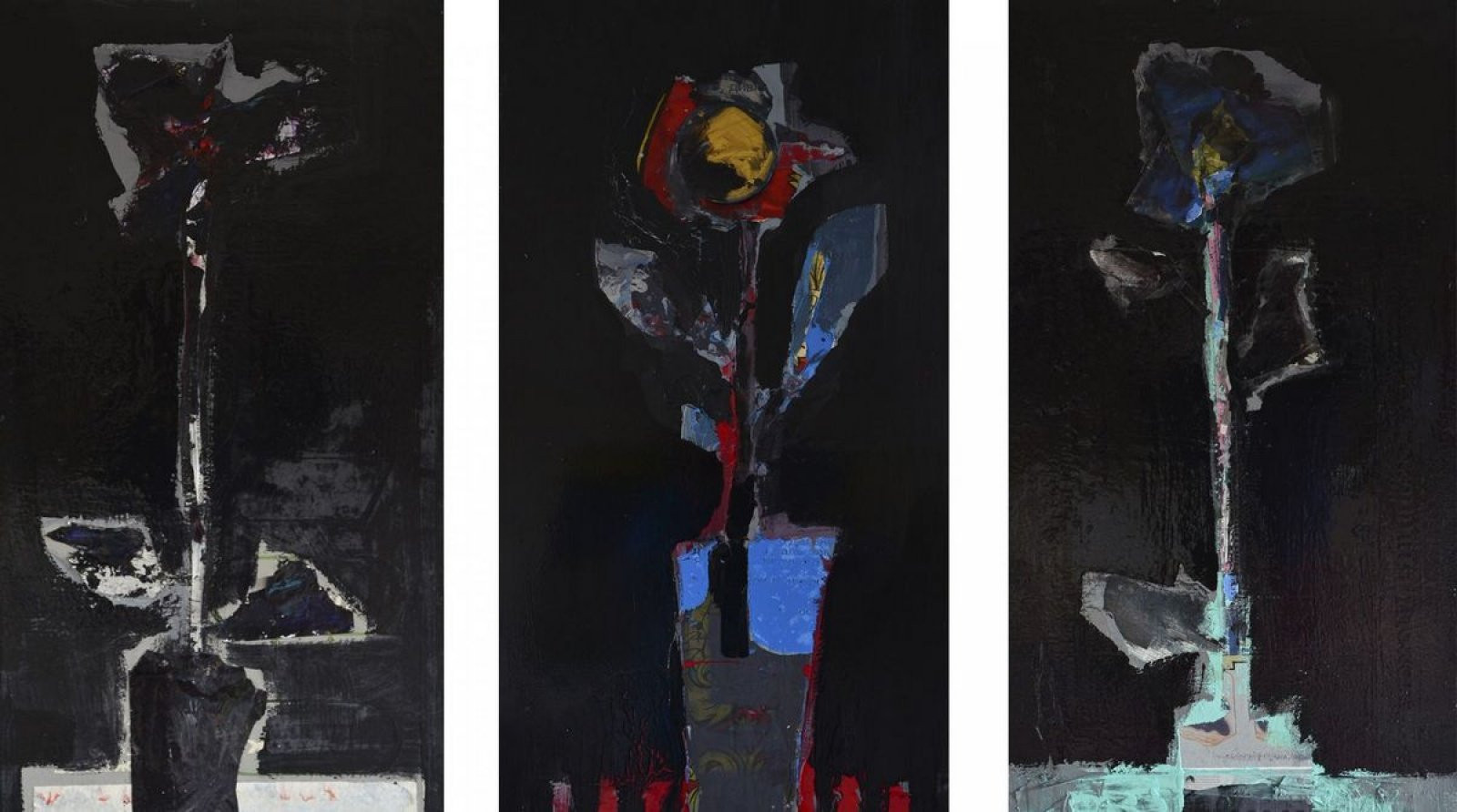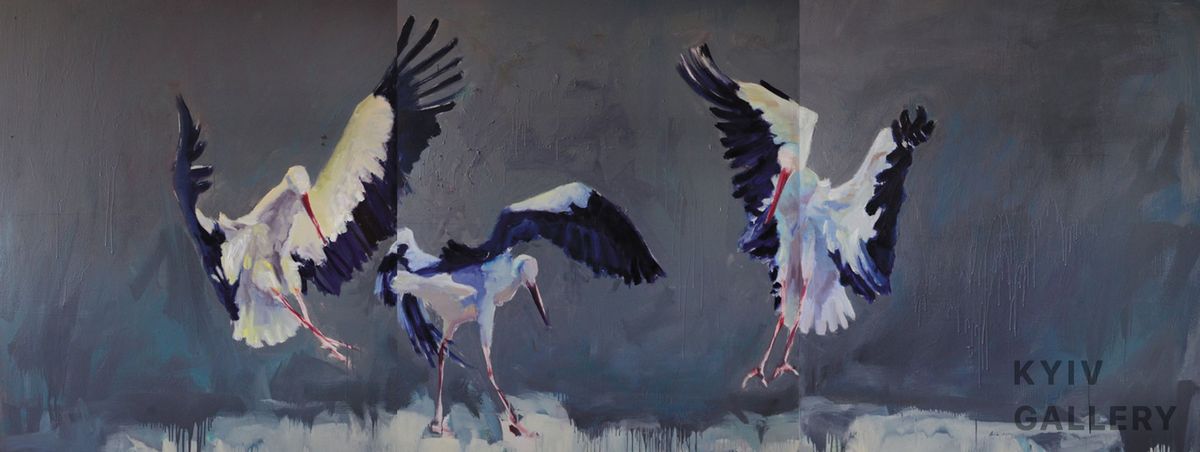

Triptych is a work of fine art consisting of three planks or panels. All parts are united by a typical composition and idea. Usually, a large central canvas is traditionally complemented by two small ones on the left and right. The boards of the triptych have their microplots, but all the meanings and artistic images are revealed only through the contemplation of the whole work. Zoning of the creative space allows you to place semantic accents in the composition and create an accessible story.
The most popular subjects of triptychs
Until the mid-nineteenth century, most triptychs were devoted to religious themes. This is explained by their initial focus on the Christian tradition and the long dominance of theocentric views in Western European culture. In that era, triptychs mainly performed a narrative function, preaching Christian doctrine through images: every detail of clothing, jewelry, and other objects on the canvas contained references to religious dogma.

Ihor Melnyk, painting "Dance. Triptych", ID 10162
Modern artists devote their works to a variety of subjects. We can find triptychs with the sea, mountains, flowers, and even horses. Most of these paintings are created for interior decoration. But the triptych still has its attractiveness for experimental artists. Some masters paint in abstractionism, skillfully using the horizontal orientation of the canvases to enhance the images visually. Even less often, artists use triptychs for portraits. For example, Francis Bacon created unique paintings of deformed bodies, which later became symbols of the inner tragedy of human existence in the modern world.
Art materials for triptychs
Initially, triptychs were painted with tempera on wooden boards, but in the Renaissance, painting began to appear on artists' palettes. Modern masters completely revised the triptych's basic concept and began using various art materials freely. Wood was used as a canvas until the twentieth century.
Today you can see paintings made with gouache, acrylic, and watercolor. Given the claims about the scale of the plot, such works are rarely performed on ordinary paper, but linen and cotton canvases are already considered traditional. The practicality of using wooden planks was also questioned.
History and further evolution of the triptych
The first triptychs appeared in the middle of the first millennium. They decorated altars and helped pious viewers to reflect on the events described in the Gospel and other books of Holy Scripture. Icon painters had a certain freedom within the canon, embodying the images of angels, saints, and prophets on wooden planks. The division of the single space of the picture into three parts also allowed for the successful integration of the work into the temple interior. Hence, the triptychs became widespread throughout the Christian part of Europe.
Several practical reasons ensured the popularity of this form of fine art in the Middle Ages:
1. Triptychs could be folded before transportation to avoid damage to the painted surface.
2. On the back of the side panels were often written additional scenes that the parishioners saw after the closed triptych.
3. The horizontal orientation of the triptychs is well combined with the elements of the temple interior.
4. The division of the picture space into three parts was consistent with the idea of the existence of God in three hypostases.
5. Horizontal zoning suggests to the viewer that the work's plot should be read from left to right.
Despite the gradual secularization of public life, European masters did not lose interest in triptychs in the Renaissance. At this time, they had the opportunity to present bolder interpretations of religious subjects to the public and use the achievements of the painting tradition of their time. Artists like Robert Campion, Jan van Eyck, Hans Memling, Hugo van der Goes, and Hieronymus Bosch used this art form.

Inna Pantelemonova, painting "Molfarki (Triptyh)", ID 11601
The most famous examples of the development of these trends are the triptychs of Hieronymus Bosch. His works have gained wide popularity due to artistic images' internal ambiguity, contradiction, and mystery. Bosch boldly experimented with form, giving life to dozens of fantastic creatures on his canvases. His multi-piece set paintings are strongly influenced by the Christian tradition's desire to fill all particles of space with meaning. This circumstance may have influenced the choice of the form of the canvas. The triptych became an ideal solution for complex stories with a multi-level plot. Some images in Bosch's paintings remained undeciphered after five centuries. After the Renaissance, the triptych went underground for several centuries. This form, as before, was used in religiously oriented painting, but no one achieved significant success significant for the tradition of fine art during this period.
Triptychs in the works of contemporary artists
Nowadays, artists prefer triptychs when working on paintings with extensive plots. The division of the canvas into three parts allows for the demonstration of temporary metamorphoses and essential differences of objects or to cover more expansive areas of space. Francis Bacon remains the most popular creator of triptychs among famous artists. He owns several works dedicated to the human body: "Three Etudes for Figures at the Base of the Crucifixion" (1944), "Three Etudes of a Human Head" (1953), "Three Figures in a Room" (1964), "May-June 1973" (1973), "Etude for Self-Portrait" (1985-1986). Their most expensive triptych of Bacon was the work "Three sketches for the portrait of Lucien Freud" (1969). It was sold at Christie's auction in New York for a record 142.4 million dollars. The paintings described the history of the artist's friendship with L. Freud, who was an ideological associate of the master for many years.
The most famous triptychs
1. "The Garden of Earthly Delights." The work of the Dutch master impresses with its complexity and ambiguity of interpretation of the plot. The central part is dedicated to the temptations of our world. The left leaf depicts the moment of Adam and Eve's stay in paradise with God. And the right flap shows the afterlife of people who succumbed to the temptation of lust. The work is full of images of fantastic creatures that seem to be aliens from another world. Despite the abundance of details, the work retains the unity of the narrative. Today it is difficult to understand how contemporaries perceived Bosch's work, but there was no persecution from the church authorities. It is believed that the source of inspiration for the artist was the musical work "Vision of Tundal," dedicated to the journeys of visionaries to the afterlife.
2. "Exaltation of the Cross." Triptych by Flemish painter Peter Paul Rubens painted in the early XVII century. While remaining faithful to the traditional imagery for paintings of this genre, the artist still departs from the canons. The viewer observes the process of execution with all its terrible details. The master managed to give the story dynamism due to the unsurpassed play of light and shadow. Side panels have micro plots that reveal the meaning of the central narrative.
3. "Three studies for the crucifixion." The monumental work was created in 1962. In this work, the master continued his creative rethinking of the biblical story of the crucifixion, which he had started earlier. This work was one of the few that Bacon created in a drunken state. Traditional Christian art motifs of the crucifixion are hard to read. The author departed from the canons, deliberately using images of mutilated animal flesh. The spatial and temporal sequence of the story is also broken: the plot can be read without a strict orientation from left to right.
Triptych: paintings by Ukrainian masters
In contemporary Ukrainian art, the triptych as an art form is used when working on monumental works or to reveal extensive narratives. For example, in 2019, a mural with whales was presented in Kharkiv on Ludwig Svobody Avenue, which was recognized as a record for Ukraine. In easel painting, the form has long ceased to be associated with dramatic stories from the Holy Scriptures: domestic masters paint triptychs with still lifes, landscapes, and abstract images.

Olena Samoilyk, painting "Amid the garden", ID 11073
But the most famous among Ukrainian triptychs of our time is "Monologue" by Ivan Marchuk, written by him in March 1986. Distorted, deformed figures of people hang in an airless space with their faces down. The inner dialogue is accompanied by spiritual tension, traced in the first moments of visual contact with the paintings. The iridescent color scheme enhances the feeling of anxiety and suspicion of something terrible. The artist believes that his work became a sad sign of the tragic events in Ukraine in April of the same year at the Chornobyl nuclear power plant. This may be the case when the creative genius foresaw the events destined to happen.
KyivGallery art critic
